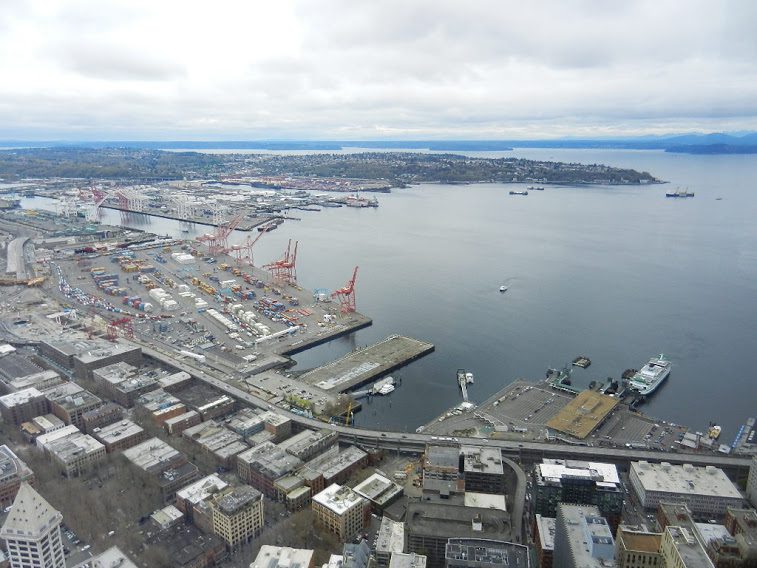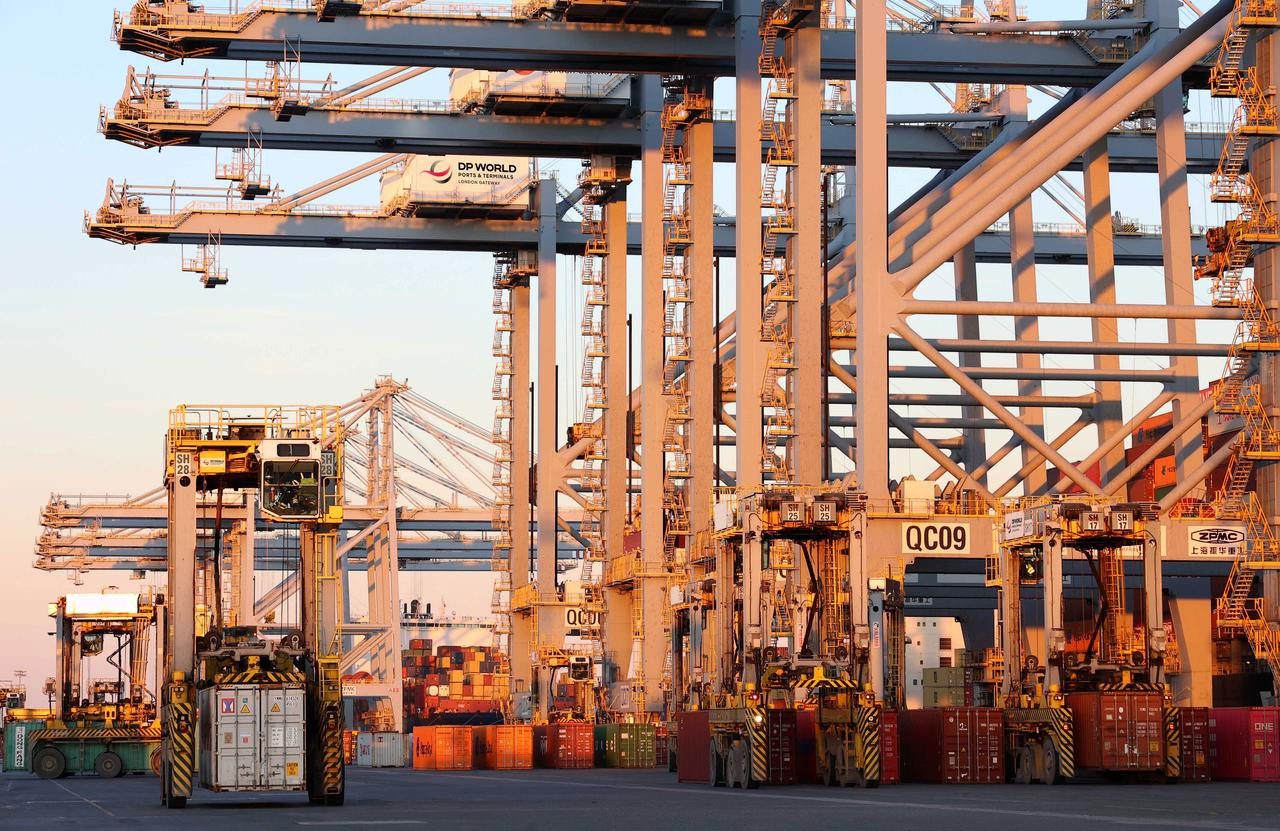Port of Seattle. Photo (c) Stefan Wolczko
By Peter Robison and Thomas Black
Oct. 31 (Bloomberg) — Seattle and Tacoma are being stymied in their push to regain market share from Canada as railcars destined for the harbors sit idle on tracks across the U.S. Pacific Northwest.
Even as the ports, on Washington’s Puget Sound, agreed to consolidate some operations after a century of competition, 40- fold growth in shipments of crude from the Bakken oil fields is straining the region’s main railroad company, BNSF Railway Co., causing delays that have helped shift traffic to less congested harbors in Canada. In September, as many as 150 grain cars piled up in nearby rail yards, said Dale Frazier, manager of Seattle Bulk Shipping Inc.
“We were turning away business,” Frazier said by phone on Oct. 28. His company transfers grains, peas and lentils from hopper railcars into containers for export. His customers racked up $170,000 in extra storage bills in September, up from $30,000 in July, he said.
The jams, part of nationwide bottlenecks that have led to complaints from farmers and scrutiny from federal regulators, are complicating the ports’ efforts to reverse losses in market share to Canadian harbors that have developed more modern infrastructure for rail shipments.
In the U.S., shippers of grain, coal and other commodities have told regulators of poor service from BNSF, owned by Warren Buffett’s Berkshire Hathaway Inc. The U.S. Surface Transportation Board in June ordered railroads to report plans for resolving the backlogs.
Help Coming
Customers “are experiencing gradual improvements” and “have our continued commitment that we will add the resources necessary to handle all of our customers’ business,” BNSF spokeswoman Courtney Wallace said by e-mail Oct. 30. This year, BNSF plans a record $5 billion in capital spending, about $1 billion of it to improve and expand lines between the Northwest and Chicago, she said. Projects include adding two new staging tracks near Everett, Washington, and improving a rail yard in south Seattle, Wallace said.
BNSF’s investments may ease the bottlenecks for the ports, said Tony Hatch, a New York-based transportation analyst at ABH Consulting.
“As much as they’re griping about it, everybody assumes that by next spring they’ll be back to normal,” he said.
While containerized cargo volumes moving through North American West Coast ports have almost doubled since 2000, the Puget Sound’s market share has dropped to 9 percent from 15 percent, according to the Port of Tacoma.
Seattle and Tacoma said Oct. 7 they will combine planning, operations and marketing of their cargo terminals. Together, they would have trailed only ports in Los Angeles, Houston, Newark and Long Beach last year, with $77 billion in total vessel trade. The aim is to halt a loss of port calls by international shippers that’s especially damaged the Port of Seattle, causing a 26 percent drop in container volume from 2010 to 2013.
Cost Savings
By combining, the two say they can stop undercutting each other on rates, spread capital investments between them and reduce costs.
“There is a short list of components of what the focus is: and it is infrastructure, and it is growing the cargo volume through here, which includes a lot of the marketing and customer relationships,” Linda Styrk, seaport managing director of the Port of Seattle, said in an Oct. 17 interview.
Asian-made goods increasingly are bypassing the Puget Sound for Canada’s Prince Rupert, 36 hours’ sail closer to Shanghai. It has a wharf deep enough for some of the biggest vessels and a cargo terminal that can whisk containers directly to rail lines for the U.S. Midwest. The British Columbia town of 15,000 people in 2007 opened the Fairview Terminal, the first dedicated ship- to-rail container terminal in North America.
Volume Surges
Prince Rupert’s volume jumped 14 percent in the year through September, to 457,131 standard containers, or 20-foot equivalent units (TEUs). Volume in Seattle and Tacoma was almost unchanged at 2.6 million in the same period, the ports say. Port Metro Vancouver, which consolidated the operations of three regional ports in 2008, saw volume increase 4.7 percent to almost 2.2 million TEUs in the year through September.
“Fundamentally, we’ve got some good advantages, but it takes the collaboration between all the modes of shipping — the carriers, the terminal operators and the railway to make it all work,” Shaun Stevenson, the Prince Rupert Port Authority’s vice president of trade development and public affairs, said by phone on Oct. 24.
BNSF is the main carrier hauling crude from the Bakken shale formation centered in North Dakota to oil refineries in Washington State. The amount of oil hauled by trains in the U.S. rose more than 40-fold to 407,761 carloads in 2013 from five years earlier, according to the Association of American Railroads.
$67 Million
For the week ending Oct. 25, BNSF reported that 615 of its loaded grain cars and 103 intermodal cars, or shipping containers put onto rail, sat for 120 hours or more. Union Pacific, the other major West Coast railroad, says it had 144 loaded grain cars and 74 intermodal cars stalled for the week ending Oct. 24.
The National Corn Growers Association wrote to the Surface Transportation Board Sept. 4, citing a North Dakota State University study that estimated farmers in that state alone have lost $67 million because of rail shipment delays.
At the Port of Tacoma, the advertised five-day rail journey to the U.S. Midwest is taking seven or eight days because of a shortage of rail cars and crews, said spokeswoman Tara Mattina.
A BNSF rail line serving the port doesn’t have enough capacity, said Gary Hofmann, manager of Tacoma Transload Inc., which puts grain into containers.
“If we have freight trains passing through town, you can’t service the intermodal,” Hofmann said by phone Oct. 28. “I know BNSF is building more, but there are still a lot of pinchpoints.”
$100 Tax
Even if the infrastructure is improved, it leaves the Puget Sound ports wrestling with other long-term challenges, among them a shift to bigger vessels and a U.S. tax of more than $100 per container. Canada has no such fee.
Congress is being pressed to alter or eliminate the so- called harbor maintenance tax. While the tax dates to 1986, the Northwest ports say the modernized Canadian harbors are in better position to exploit the price advantage it gives them.
As many as half of U.S.-bound containers pass through Canada’s Western ports because of the tax, the Federal Maritime Commission said in 2012. Seaborne imports that enter the U.S. by rail from Canada aren’t charged a similar tax.
“We’ve got to get that changed,” U.S. Representative Jim McDermott, a Democrat from Washington state, said in an Oct. 6 interview. “They’re eating our lunch.”
The stakes are only getting higher for ports as vessels get bigger and unload more cargo at each stop, reducing the total number of port calls.
“That same volume that used to be distributed across seven gateways now might be distributed across three,” said the Port of Seattle’s Styrk. “It means there are going to be winners and losers.”
Copyright 2014 Bloomberg.

 Join The Club
Join The Club











